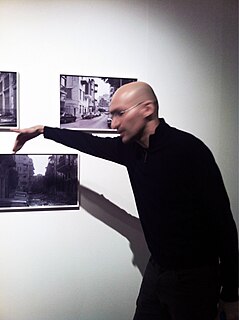
The culture of Lebanon and the Lebanese people emerged from various civilizations over thousands of years. It was home to the Phoenicians and was subsequently conquered and occupied by the Assyrians, the Greeks, the Romans, the Persians, the Arabs, the Crusaders, the Ottoman Turks and the French. This variety is reflected in Lebanon's diverse population, composed of different religious groups, and features in the country's festivals, literature, artifacts, cuisine and architecture of Lebanon. Tourism in Lebanon is popular with periods of interruption during conflict.

Heritage Documentation Programs (HDP) is a division of the U.S. National Park Service (NPS) responsible for administering the Historic American Buildings Survey (HABS), Historic American Engineering Record (HAER), and Historic American Landscapes Survey (HALS). These programs were established to document historic places in the United States. Records consist of measured drawings, archival photographs, and written reports, and are archived in the Prints and Photographs Division of the Library of Congress.
Walid Phares is a Lebanese-born American scholar and conservative political pundit.

Haret Hreik is a mixed Shia and Maronite Christian municipality, in the Dahieh suburbs, south of Beirut, Lebanon. It is part of the Baabda District. Once an agricultural village, Haret Hreik lost its rural identity due to the wave of refugees from Southern Lebanon who settled in the town and made it another urban neighborhood of Dahieh.
DOCAM was an international alliance of researchers from various institutions and disciplines dedicated to the documentation and conservation of media arts. The project was the result of a five-year mandate lasting from 2005 until 2010. Outcomes of the project include a cataloguing guide incorporating case studies, a conservation guide explaining preservation issues specific to time-based media, a technological timeline, a documentation model for digital curation and preservation of time-based media, and a glossary and thesaurus for media arts.

Walid Raad (Ra'ad) is a contemporary media artist. The Atlas Group is a fictional collective, the work of which is produced by Walid Raad. He lives and works in New York, where he is currently a professor at the School of Art at the Cooper Union School of Art.

The General Archive of the Nation are the national archives of Argentina. It is a body under the Ministry of the Interior, which aims to collect, order and keep the documentation that the law entrusts to it, to spread knowledge of the sources of Argentine history.

Europeana is a web portal created by the European Union containing digitised cultural heritage collections of more than 3,000 institutions across Europe. It includes records of over 50 million cultural and scientific artefacts, brought together on a single platform and presented in a variety of ways relevant to modern users. The prototype for Europeana was the European Digital Library Network (EDLnet), launched in 2008.
Domaine de Bargylus is a wine estate on the slopes of the Coastal Mountain Range in Syria. These mountains, known as Mount Bargylus in the Hellenistic and Roman periods, produced notable wines up until the rise of Islam. Domaine de Bargylus is managed by two brothers Karim and Sandro Saadé, with the assistance of renowned consultant Stéphane Derenoncourt. It has been cited by wine critic Jancis Robinson as "arguably the finest wine of the Eastern Mediterranean".
A superfiction is a visual or conceptual artwork which uses fiction and appropriation to mirror organizations, business structures, and/or the lives of invented individuals (Hill). The term was coined by Glasgow-born artist Peter Hill in 1989. Often superfictions are subversive cultural events in which the artwork can be said to escape from the picture frame or in which a narrative can be said to escape from the pages of the novel into three-dimensional reality. While this may involve a moment of deception regarding the origin, background and context of the presentation, or the veracity of claimed facts, deceit is only a method, intended to condition the observer's perception in a certain way, and it is not the ultimate goal of this artistic practice. Superfictions explore the interaction between the observer's concepts and the actual "objective" evidence that is presented; this is fundamentally analogous to e.g. arranging lines on a two-dimensional sheet to create a perspective illusion, even though the actual works of superfiction often are perceived to push the boundaries of what is considered to be "art".

Lokman Mohsen Slim was a Lebanese Shiite publisher, political activist and commentator, who promoted a Culture of Remembrance to cope with the many past and present conflicts of Lebanon and the whole region. Slim was known to be a prominent critic of Hezbollah but also critical of all other sectarian parties. He was found shot to death in his car in Hezbollah-dominated southern Lebanon. Many people, including Slim's sister have alleged Hezbollah to have committed the assassination, a charge that Hezbollah has denied.
Lamia Joreige is a Lebanese visual artist and filmmaker. She received a BFA from Rhode Island School of Design, Providence, Rhode Island. Since the late 1990s, her works have been widely displayed. She is a co founder and co director of the Beirut Art Center. In 2011, Sandra Dagher and Lamia Joreige organized “Museum as Hub: Beirut Art Center” at New York City's New Museum.
Gregory Buchakjian is a Lebanese photographer, filmmaker and art historian. He studied at the Paris-Sorbonne University. He is the director of the School of Visual Arts at Académie Libanaise des Beaux-Arts ALBA and was co founder, with architects Pierre Hage Boutros and Rana Haddad, of Atelier de Recherche ALBA.
Sandra Dagher is a Lebanese curator. Considered as an “art activist”, she currently is the advisor and head of programs of the Saradar Collection.
The Archives of American Gardens is an archive dedicated to preserving documentation and content related to gardens in the United States. Established in 1992, the Archives are located in Washington, D.C., United States, and are maintained by Smithsonian Gardens, a unit of the Smithsonian Institution.
Walid Sadek is a Lebanese artist and writer. He is a professor at the Department of Fine Arts and Art History of the American University of Beirut, and held its chairmanship from 2017 to 2020.

Nemer Saadé is a Lebanese fashion designer who is the Creative Director of the eponymous luxury brand Nemer Saade.

The documentation of cultural property is a critical aspect of collections care. As stewards of cultural property, museums collect and preserve not only objects but the research and documentation connected to those objects, in order to more effectively care for them. Documenting cultural heritage is a collaborative effort. Essentially, registrars, collection managers, conservators, and curators all contribute to the task of recording and preserving information regarding collections. There are two main types of documentation museums are responsible for: records generated in the registration process—accessions, loans, inventories, etc. and information regarding research on objects and their historical significance. Properly maintaining both types of documentation is vital to preserving cultural heritage.
The Center for Contemporary Jewish Documentation is an independent French organization founded by Isaac Schneersohn in 1943 in the town of Grenoble, France during the Second World War to preserve the evidence of Nazi war crimes for future generations. After the Liberation, the center was moved to Paris in 1944 where it remains today.

The Museum of Fine Arts of São Paulo (MuBA) is a university museum located in the neighborhood of Vila Mariana, in the city of São Paulo, Brasil. It opened on September 23, 2007 and was officially registered on April 14, 2008. The museum is connected to the Fine Arts University Center of São Paulo, a private institution of higher learning, and is sustained through the School of Fine Arts Foundation of São Paulo (FEBASP).











